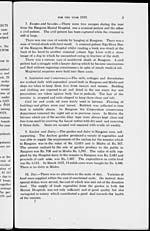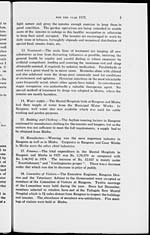Medicine - Mental health > 1925-1940 - Note on the mental hospitals in Burma > Note on the mental hospitals in Burma for the year 1925
(14) Page 4
Download files
Individual page:
Thumbnail gallery: Grid view | List view

4 NOTE ON THE MENTAL HOSPITALS IN BURMA
11. Amusement and Recreation.—Various methods were adopted to
amuse the inmates and to relieve the monotony of life of an asylum.
In Rangoon monthly pwès, frequent musical and gramophone entertain-
ments and annual sports continued to be held. Successful competitors
were awarded prizes of small sums of money, sweets, etc. The Rangoon
Corporation Band continued to play in the asylum premises. Burmese
and English newspapers and magazines were supplied to the sane and well
behaved inmates. They were also permitted to visit Pagodas, Churches
and their relatives in charge of attendants ; outdoor and indoor games
were encouraged and cigars and cigarettes were also supplied. Friends
and relatives were permitted to visit the inmates on Sundays between 1
and 3 p.m. and on other days with special permission. Sayadaw U
Nyaneinda of Zedawun monastery of Bahan continued to preach on
Sundays and on festival days to the well behaved inmates at Rangoon.
At Minbu " Asylum Day " was celebrated for the first time in the
history of the Mental Hospital during Xmas week, when sports were
held in the asylum compound with a pwè in attendance. The sports
were very successful and enjoyed by all the inmates.
Thanks are due to the undermentioned donors for their kind gifts to
the " Recreation Fund " at Rangoon :—
|
Rs. |
|
|
(1) His Excellency the Governor of Burma ... |
75 |
|
(2) Mr. Aga Ahamed Sherajee ... ... |
300 |
|
(3) Mr. A. Chinnasawmy ... ... ... |
50 |
|
(4) Collection by Mrs. H. M. Nunn, the Matron ... |
1,314 |
|
(5) Sun Press ... ... ... ... |
Vernacular Daily Paper. |
|
(6) Ladies Xmas Committee ... ... |
Rs. 5, cakes, sweets and live- |
|
stock. |
|
|
(7) Mr. Hogg ... ... ... ... |
Illustrated newspaper. |
|
(8) Judson College ... ... ... |
Newspapers. |
|
(9) Marwari gentlemen ... ... ... |
Sweets. |
12. Employment.—In Rangoon the daily average number of inmates
employed on various works was 325.90. Inmates were not forced to
work in any sense as a punitive measure, but for health considerations.
Such of them as were capable, were induced to work and rewarded by
stipends of small sums of money. The common form of employment of
both male and female patients was keeping their quarters, and the garden
clean, assisting the staff of keepers to look after the helpless cases, food
distribution, tailoring and washing clothes. More strenuous forms of
work for the male patients were gardening, paddy grinding, water
carrying, weaving, assisting in the kitchen, masonry and carpentry
work and work in the dairy while the female patients did the rice
cleaning.
In Minbu the major portion of the inmates were employed in
gardening, weaving, tailoring, paddy grinding and general cleaning of the
asylum premises and in attending to the sick inmates. The work is of a
Set display mode to: Large image | Zoom image | Transcription
Images and transcriptions on this page, including medium image downloads, may be used under the Creative Commons Attribution 4.0 International Licence unless otherwise stated. ![]()
| India Papers > Medicine - Mental health > Note on the mental hospitals in Burma > Note on the mental hospitals in Burma for the year 1925 > (14) Page 4 |
|---|
| Permanent URL | https://digital.nls.uk/83981764 |
|---|




